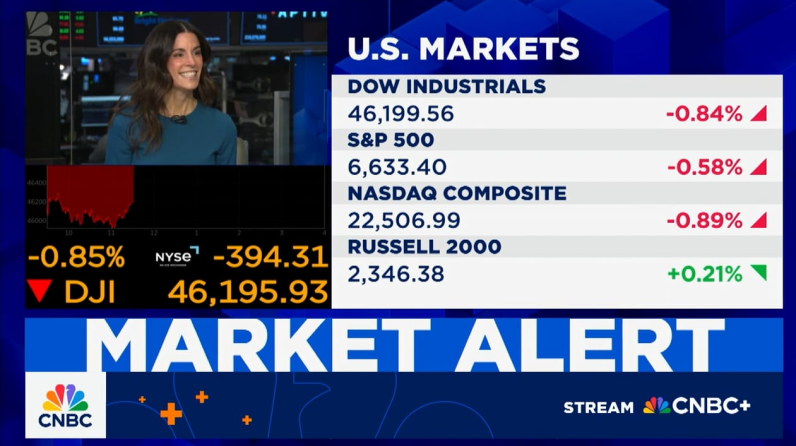

While slowing job gains -- albeit with a lack of primary data due to the shutdown -- drove the cut, secondary data is indicating a still soft environment.
Even as the U.S. government shutdown drags on, there is still some business getting done in Washington D.C. The Federal Open Market Committee (“FOMC”) announced that it lowered the fed funds target rate by 25 basis points to 3.75% to 4.0% as the voting members continue to weigh the threat represented by a soft labor market, even without the data to back it up. Interestingly, there were two dissents to today’s rates decision: Stephen Miran, who once again voted for a 50-basis point cut, and Jeffrey Schmid, who voted to maintain rates at the previous level. In addition, the Fed announced an end to quantitative tightening on December 1st, having removed over $2 trillion from the Fed’s balance sheet since the program began in July 2022.
Driving the decision to cut rates were slowing job gains, at least through the last reporting period of August. The statement did, however, note the inflection higher in inflation from the beginning of the year, reflecting the pull through of higher costs due to tariffs. This concern about inflation was apparent during Fed Chair Jerome Powell’s press conference as well as he characterized today’s interest rate cut as a “risk management move” and cautioned that a rate cut in December was “not a foregone conclusion.” In addition to concerns about higher prices, Powell’s comments also seemed to amplify the view that the U.S. economy is delivering growth at a “moderate” pace and that there are members of the FOMC who are hesitant to cut rates if stronger growth is ahead.
Today’s decision to lower rates and wind down quantitative tightening are accommodative and certainly reflect the Fed’s continued concerns around the “curious” labor market. Even without the primary data typically available to the FOMC, secondary data, as well as recent company announcements, indicate that the pace of hiring remains slow and that layoffs may be accelerating. The resolution of the U.S. government shutdown should allow for a resumption in the collection and reporting of employment and inflation data, however, given the length and timing of the shutdown, we are likely to be evaluating a noisy set of numbers at least through the end of 2025. In addition, the specter of higher inflation due to a combination of higher costs and stronger growth looms a little larger today and shifts the focus back to the dual mandate.
Markets were surprised by the hawkish tone of the statement, Powell’s comments at the press conference, and the Schmid dissent. The probability of a Fed cut in December fell from over 90% to closer to 60%, and that could drift even lower in the next few weeks as the FOMC members hit the speaker circuit. Interest rate sensitive sectors were hit in the afternoon trading session, as were U.S. small caps; Treasury yields, and the dollar were higher on the news.
In terms of our investment views, we continue to anticipate that modestly lower rates and improving economic growth will provide a tailwind for small and mid-cap stocks as we move into 2026. In addition, the U.S. dollar is unlikely to strengthen against the current backdrop, which supports investment in non-U.S. equities. Finally, we believe there are opportunities in lengthening duration, as cash yields are drifting lower and there is a benefit to locking in yields further out on the curve.


INSIGHTS
CIO Notebook: Powell Plays the Middle as Fed Cuts Rates

MARKET COMMENTARY
Giving Thanks for Market Strength

INSIGHTS
CIO Notebook: September U.S. Non-Farm Payrolls Further Complicate the Narrative

VIDEO
Holly Newman Kroft Featured on CNBC’s Money Movers November 18

VIDEO
Plan for Peace of Mind with Our Estate Planning Organizer

MARKET COMMENTARY
Some Tricks, More Treats

INSIGHTS
CIO Notebook: Markets Rattled as Fed Leans Hawkish
REPLAY
Private Wealth Investment Outlook 4Q25
INSIGHTS
CIO Notebook: September Core CPI Comes in Late but Light
INSIGHTS
Charitable Fundraising: Moving Beyond Cash
INSIGHTS
The ‘Disruptive Ds’ Powering Commodities Markets
INSIGHTS
Expanding Horizons in Fixed Income
INSIGHTS
Year-End Planning: Key Considerations for 2025 and Beyond
IMPORTANT INFORMATION:
This material is provided for informational purposes only and nothing herein constitutes investment, legal, accounting or tax advice, or a recommendation to buy, sell or hold a security. This material is general in nature and is not directed to any category of investors and should not be regarded as individualized, a recommendation, investment advice or a suggestion to engage in or refrain from any investment-related course of action. Any views or opinions expressed may not reflect those of the firm as a whole. Neuberger Berman products and services may not be available in all jurisdictions or to all client types. Diversification does not guarantee profit or protect against loss in declining markets. Investing entails risks, including possible loss of principal. Investments in private equity are speculative and involve a higher degree of risk than more traditional investments. Investments in private equity are intended for sophisticated investors only. Unless otherwise indicated, returns shown reflect reinvestment of dividends and distributions. Indexes are unmanaged and are not available for direct investment. Investing entails risks, including possible loss of principal. Past performance is no guarantee of future results.
Portfolio positioning views expressed herein are those of Neuberger Berman’s Private Wealth Investment Group, which may include those of the Neuberger Berman’s Asset Allocation Committee. Asset allocation and positioning views are based on a hypothetical reference portfolio. The Private Wealth Investment Group analyzes market and economic indicators to develop asset allocation strategies. The Private Wealth Investment Group works in partnership with the Office of the CIO. The Private Wealth Investment Group also consults regularly with portfolio managers and investment officers across the firm. The Asset Allocation Committee is comprised of professionals across multiple disciplines, including equity and fixed income strategists and portfolio managers. The Asset Allocation Committee reviews and sets long-term asset allocation models, establishes preferred near-term tactical asset class allocations and, upon request, reviews asset allocations for large, diversified mandates. Asset Allocation Committee members are polled on asset classes and the positional views are representative of an Asset Allocation Committee consensus. The views of the Asset Allocation Committee and the Private Wealth Investment Group may not reflect the views of the firm as a whole and Neuberger Berman advisers and portfolio managers may take contrary positions to the views of the Asset Allocation Committee or the Private Wealth Investment Group. The Asset Allocation Committee and the Private Wealth Investment Group views do not constitute a prediction or projection of future events or future market behavior. Defensive positioning generally means an underweight bias on allocations to risk assets such as equities and alternatives. Positioning views may change over time without notice and actual client positioning may vary significantly. Discussion of yield characteristics or total returns of different asset classes are for illustrative purposes only. Such asset classes, such as equities and fixed income, may have significantly different overall risk-return characteristics which should be consider before investing.
The information in this material may contain projections, market outlooks or other forward-looking statements regarding future events, including economic, asset class and market outlooks or expectations, and is only current as of the date indicated. There is no assurance that such events, outlook and expectations will be achieved, and actual results may be significantly different than that shown here. The duration and characteristics of past market/economic cycles and market behavior, including any bull/bear markets, is no indication of the duration and characteristics of any current or future be market/economic cycles or behavior. Information on historical observations about asset or sub-asset classes is not intended to represent or predict future events. Historical trends do not imply, forecast or guarantee future results. Information is based on current views and market conditions, which will fluctuate and may be superseded by subsequent market events or for other reasons.
Discussions of any specific sectors and companies are for informational purposes only. This material is not intended as a formal research report and should not be relied upon as a basis for making an investment decision. The firm, its employees and advisory accounts may hold positions of any companies discussed. Nothing herein constitutes a recommendation to buy, sell or hold a security. It should not be assumed that any investments in securities, companies, sectors or markets identified and described were or will be profitable. Investment decisions and the appropriateness of this content should be made based on an investor's individual objectives and circumstances and in consultation with his or her advisors.
Neuberger Berman Investment Advisers LLC is a registered investment adviser.
The “Neuberger Berman” name and logo are registered service marks of Neuberger Berman Group LLC.